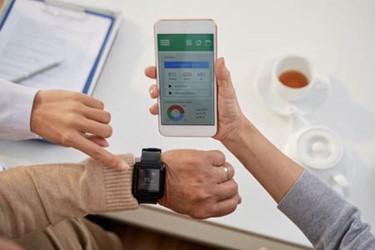Is Your Clinical Trial Ready To Go Digital?

By Ed Miseta, Chief Editor, Clinical Leader

Digital clinical trials are a popular topic in the life sciences industry. But for all the talk we hear about the use of wearable devices in trials, it’s often hard to gauge exactly how many companies are using these devices. Fortunately, Dawn Anderson, managing director of life sciences strategy and operations in the R&D practice at Deloitte, has good insights into the adoption of these technologies.
I recently had the opportunity to touch base with Anderson to discuss digital technologies and wearable devices, to learn where we stand, what companies are doing, and where we go from here.
Ed Miseta: What companies do you see implementing digital technologies?
 Dawn Anderson: We are seeing implementation of these digital capabilities and technologies across the board. We are certainly seeing the implementation of these technologies in large, global, top 20 pharma companies. But midsize biotech and medtech companies, as well as CROs, are running digital trials and even those that have not to date are planning to do pilots studies with digital devices soon. Maybe surprisingly, some of the most advanced groups who are leading the way for digital clinical trials are the academic research organizations.
Dawn Anderson: We are seeing implementation of these digital capabilities and technologies across the board. We are certainly seeing the implementation of these technologies in large, global, top 20 pharma companies. But midsize biotech and medtech companies, as well as CROs, are running digital trials and even those that have not to date are planning to do pilots studies with digital devices soon. Maybe surprisingly, some of the most advanced groups who are leading the way for digital clinical trials are the academic research organizations.
Miseta: When companies come to you for help, what exactly are they looking for?
Anderson: Pretty much all aspects of a trial. When they first approach us, I always ask them how they define a digital trial. I always receive a wide range of definitions. Some are trying to drive efficiency in productivity. They want to streamline the processes and paper they must go through when executing a trial. Others are looking at connected medical devices and trying to figure out how to add a new data input stream to their protocols. Still others are much more advanced and are looking into how to run virtual clinical trials. They want fewer site visits and more data collected outside patients visiting a doctor’s office. When putting that new model in place they need help with recruitment and better ways to engage patients and improve retention.
We primarily help them to understand what they want to do with digital clinical trials, how to create a roadmap to get there, and how to best execute those plans. That involves designing protocols, engaging patients, and helping them to identify the right vendors with the right technologies to help them run those trials.
Miseta: What types of devices are companies investing in?
Anderson: This is a very exciting area right now and we are seeing an explosion of devices making their way into trials. First it was Fitbit and Garmin trackers, and then the Apple Watch. Apple, Google and Amazon are doing a lot of work in that space. Now we are seeing is a lot of diagnostic and interventional types of devices starting to get incorporated. Glucometers for diabetes and even devices that allow EKGs to be taken remotely. Not everyone is using advanced, Bluetooth-enabled technologies, but we are seeing many remote data capture devices moving through the approval process. I expect that very soon there will be many tests of the common protocol activities and tests that sponsors will be able to run remotely.
Miseta: What are Big Pharma companies doing to make digital trials a reality?
Anderson: Many are hiring chief digital officers while others are designated a patient engagement leader to drive the effort. But I think the real positive behind making digital trials reality is companies looking at clinical trials from the patient perspective to understand what works best for them. That involves talking to patients, patient communities, patient advocacy groups, and investigators and asking what they like about trials and what can be improved. By applying that feedback to the trial design process, companies are figuring out ways to use technology to be more patient centric.
The result can be something as simple as an app that reminds them to take their medicine or getting a patient’s permission to track their symptoms. Here is a complaint I recently heard from a patient. She would go to her clinical trial visit once a month and be asked about her symptoms. She noted it was impossible to remember her symptoms for the entire month, especially those from 30 days ago, so she started using an Excel spreadsheet to track her symptoms. The digital trail solution was to create an app on the patient’s smart phone that will ask them for that information every day. It’s little things like that which will help us make trials better and easier for patients. We need to incorporate more of those ideas into trials, it improves the quality of the data and is patient engagement at its finest.
Miseta: Are we seeing this uptake in certain therapeutic areas?
Anderson: That’s an interesting question. We really thought we would see adoption of these technologies in certain areas, like diabetes and dermatology studies. But the truth is we are seeing adoption of these technologies in respiratory, gastroenterology, cardiac, and many other indications. We are even seeing interest in these technologies in oncology studies. We cannot yet perform a CT scan remotely, but we are still able to collect interim data from a lot of connected devices. Weight, blood pressure, EKG readings, and information about a patient’s ability to answer cognitive questions. It’s exciting to see this range of use in trials. Every implementation is getting us closer to site-less trials and more digital and virtual trials.
Miseta: Are you hearing any concerns about the cost of these technologies?
Anderson: Cost is always a concern in clinical trials. But at the same time, when I ask clients why they are looking into using digital technologies, one of the responses I hear is cost effectiveness. There are upfront costs, since companies will have to make an investment in infrastructure. But over time we know companies will have cleaner and more compliant data. We believe that high-quality data will reduce the overall cost of bringing a new drug to market. I believe the impact on cost will be short term, while the benefits of using these technologies will continue to be realized in the long term. Large companies are making these investments now, while smaller companies are looking for help from their CROs and academic research organizations that have the capabilities. But we do see small and mid-sized companies making the investment and placing large bets in this space as a differentiator and way of adding value to their clinical trials.
Miseta: Will the use of these products lead us closer to true virtual trials?
Anderson: Simply defining what a virtual trial is can be a challenge, and it’s something we struggle with in our practice. That term can mean different things to different people. I look at it as a continuum. The world of digital is a giant maturity curve. We start with things like ePRO and eConsent. We then move into wearables and connected medical devices. That leads to telemedicine and home health aide visits who can go out and conduct tests in patient homes. If you continue down that path you will eventually get to a set of capabilities that most people would consider a virtual clinical trial. I believe in three to five years at least 20 percent to 30 percent of the portfolios of our largest clients will be doing some advanced form of digital trial and many of those will have strong virtual trial aspects. That is a significant number. This we hope will lead us to improved patient engagement and lead to a better experience for all patients and investigators participating in trials. As an industry we hope virtual trials will lead to a true paradigm shift that will benefit patients, investigators, and sponsors.
